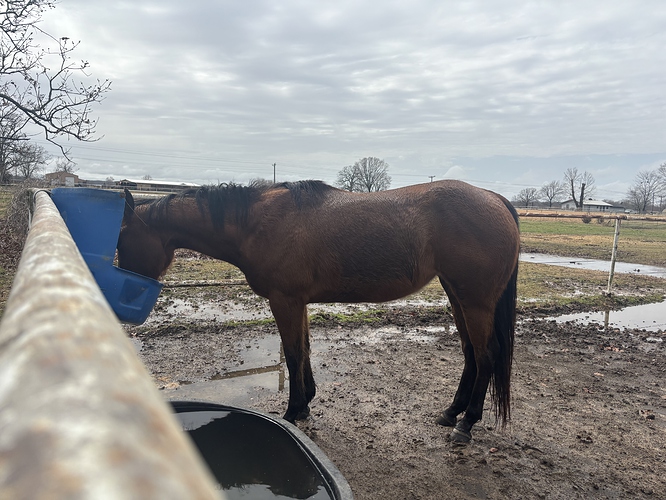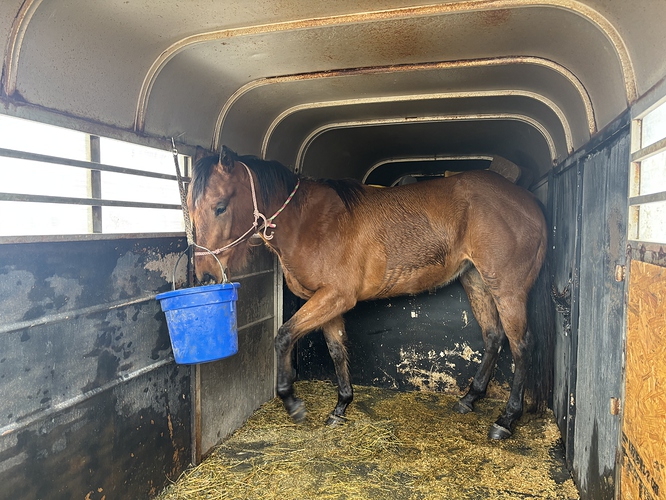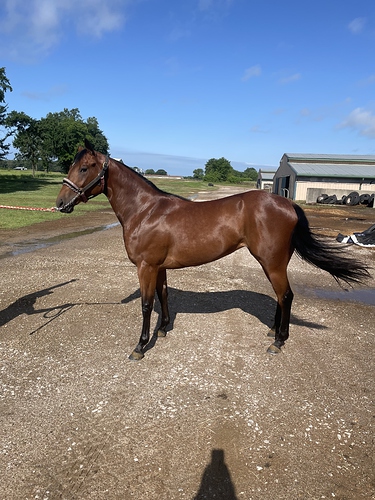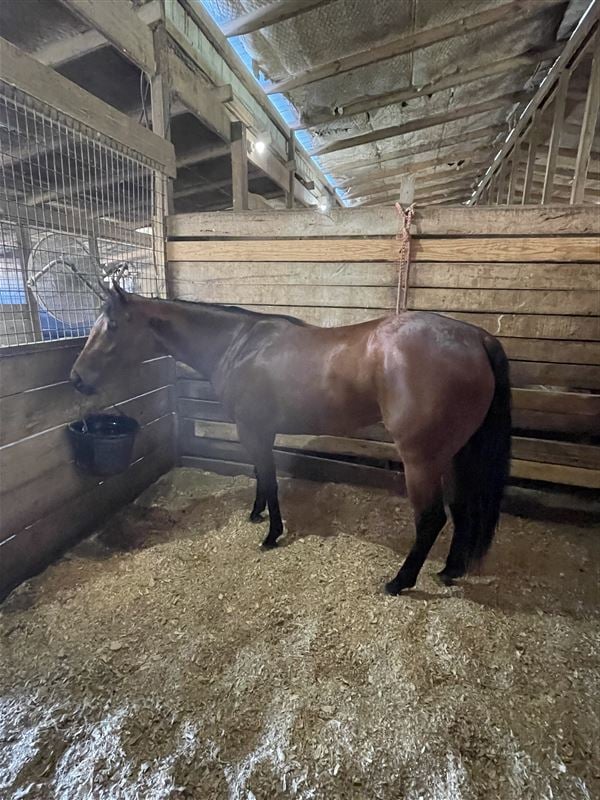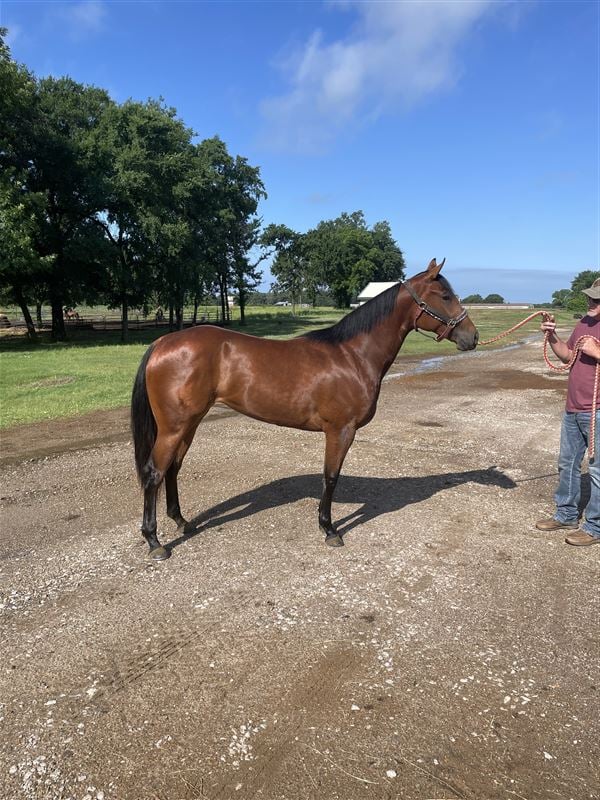I just, and I mean JUST, bought a young filly as a barrel prospect. I didn’t look at her legs too much until we got home from the 10 hour drive (stupid me  ) and I realized she seems to have sickle hocks and her back legs are a little splay footed. Her sires the Marfa Lights and it seems a lot of his babies are like this. Is this going to impact her career or give her serious soundness issues? Do I need to ask my vet, is she going to need injections?? Maybe it’s barely a cause of concern at all. Please help me out!! She’s also pretty tall, 15.2 at 3 yo.
) and I realized she seems to have sickle hocks and her back legs are a little splay footed. Her sires the Marfa Lights and it seems a lot of his babies are like this. Is this going to impact her career or give her serious soundness issues? Do I need to ask my vet, is she going to need injections?? Maybe it’s barely a cause of concern at all. Please help me out!! She’s also pretty tall, 15.2 at 3 yo.
I would like to see a photo from the tail looking toward the head. Sickle hock, as I understand it, has degrees --some worse than others. The draft horse people who actually USE their draft horses for heavy pulling want a sickle hock to a sight extent (back hoof toes out) to allow for greater effort and longer effort plowing or pulling --or so I was told back in my days of owning exactly one draft horse. The breeder chose my horse out of his 20 weanlings because he did not have sickle hocks, as my plans for him did not include pulling or plowing, but rather riding and having fun with my kids and our big white Percheron. We had him for 22 years --still miss him.
I feel like what Foxglove is describing is Cow Hocked more than sickle hocked.
Since you just got her, why not have the vet out for an appointment so they can give the horse a once over and you can discuss all your worries.
I do not see her to be horrible. She does seem to sometimes stand under herself, but after a 10 hour drive she could very well be sore and stiff and she is compensating.
She’s young. If she still stands like this at 5, then yeah. I’d be ON POINT with maintenance type stuff.
My Old Man is sickle hocked and yes, it impacted his soundness. If I knew then what I know now, though, he would have been sound way way longer.
Have the vet out to evaluate.
My pony has sickle hocks and toes out terribly on his front right and still sound at 22.
Key is maintenance and staying on top of fitness by getting them fit using lots and lots of walking.
She doesn’t look bad to me. My 5yo APHA mare is sickle hocked and splay footed in the rear. It for sure impacts her comfort levels and I’ve been warned by the vets that she’s going to need hock injections sooner than the average horse. We do a lot of walking and strengthening.
My first horse had sickle hocks, cow hocks, knock knees, his front legs turned out badly, back at the knees and IMO the best disposition of any horse in history. He was on pasture board, outside 24/7/365.
He got capped hocks twice in 20 years, no problems with his knees. I was jumping him 3’6", galloping a good bit, trail rode up and down the hills and the worse thing that happened to his front legs was “gravel”, a normal hoof abscess. He did end up with navicular, temporarily, because the farriers did not cut down his toes enough.
Some old timers told me not to worry too much and that my horse should be able to get his feet and the best place to deal with hairy situations.
Let me be the first to say “ she’s cute!”. I have one in my barn who looks a lot like this. He’s sound.
As far as barrel horses go for my own personal preferance, I do not like how her hind end looks. Hocks are too high, very little roundness to them, etc. But that’s just what I like in a barrel horse. Doesn’t mean she is going to have any long term problems.
You can have the most perfect looking horse and they can be unsound.
And you can have the most unbalanced looking horse and they might never take a lame step in their life.
Has she been started undersaddle or not yet?
Did you do a pre-purchase exam?
I’ve seen horses with terrible conformation remain sound and horses with perfect conformation have soundness issues. I think there is a greater chance of arthritis developing as the horse ages but it probably depends on how you ride, and manage your horse.
For example, if you run lots of barrels, do lots of arena work, turns and circles then your horse will have a lot more wear and tear, then if you occasionally do barrels and hack out most of the time.
I know lots of kids that just want to run and canter their horses and do the pattern repeatedly and eventually those horses will probably have issues.
My first horse was ridden 6 days a week and I probably put thousands of miles on her and yes she had an early retirement.
I don’t ride my current horses that hard. I have 2 mares in their 20s. One has some arthritis started which isn’t surprising because she has cow hocks and the other is sound except for her pssm type 2. Then I have the 2 youngsters and one more foal on the way.
Conformation may be a big deal if you are selling racehorses. But if you ride with consideration of your horse’s conformation and don’t over stress those joints, most horses will stay sound for many years.
I had someone tell me my Paso Fino would be crippled due to the way he moves. I laughed because he was probably the most athletic horse I ever owned. He did have funky back legs… probably had contracted tendons when he was born, but at any rate, he never took a lame step in the time I owned him. That horse would run for miles and fence paced a trench on my property… but you could take him out for hours and he never was tired.
He was incredibly agile. My big horses turn like trucks, compared to him. He could turn on a dime and was so nimble even the roughest of footing did not slow him down. A mountain goat of a pony…
Unless x rays show arthritis or the horse comes up lame, I would not worry about it. Your horse still has a lot of growing to do.
Seen much worse, don’t panic. She might be a little tight from 10 hours in the trailer too, Would not change the angles but might make it look worse then it is.
Is she in regular work yet?
Have the vet out for a basic new patient once over and see what they think. Whether or not it will effect her performance wise at the level you wish to compete or if there are things you can do remains to be seen.
She is nice looking and if she is easy to get along with? Might work out.
I didn’t have a PPE done but we have radiographs and such. She has been started under saddle but has not been ridden since last August. I have been riding her for the last two days and she seems to be doing well. Just a little thinner than our personal preference. I’ll be doing lots of walking and trail riding and she might look better when she’s in better shape.
Sickle hocks are over-angulation of the hock joint. She’s not sickle at all. If anything, she’s a bit straight, but she’s also butt-high so that will change once she levels out a bit
Cow hocks are when the hocks are closer together than the fetlocks, and none of these pictures show a behind view to see that
OP, can you stand her up square on level ground and get a good shot of her rear from behind her and post it?
Think as she gets back in work and finishes growing, you’ll see a big difference. I know its not a preferred gait in Western but a good trot (not a jog) with as long a straight line as you have room for as far as you can go is a great way to work both sides symmetrically. Try not to get stuck in the endless circles. Hill work, if you have any, is great and so is trotting over ground poles.
Have a co worker friend who has won a lot on her barrel horses who she buys around 3 and develops herself. This how she starts them, The disciplines are not so very different on the very basic level.
I think the BRs tend to work in long forward trotting, not the crawling jog
Depends who’s riding/training and what you are doing.
Ideally, when working on elements for the pattern when at the trot, your horse needs to be driving from behind and soft in the face. The speed of the trot really depends on the horse, and what the horse needs. As an example, for my horse Lilly, when I’m doing transition work on the pattern (trot to lope, and lope to trot), I will really over-exaggerate her trot and really slow it down to a nice collected jog. But no long trotting on the pattern ever and no posting either - I am aiming to have their entire body traveling connected, controlled, and collected in our slow work - so you achieve that from a sitting type trot.
Now if I am airing them up out on the trail, a ground covering long trot is one of the things I do for good cardiovascular exercise, among other things.
I guess I didn’t make my thought clear, my fault
slow collected work isn’t what I consider a “crawling jog”. I wasn’t referring to pattern work, just normal flat work.
My comment was really in the context of - I don’t think any good BR rider works the slow, lacking impulsion, WP jog. There’s a difference between the more collected trot/jog work and what I thought findeight was referring to as the 'crawl" of a WP jog.
IME, BRs tend to work much more in a good solid Dressage foundation, which is a good thing
findeight is right that the early work on this horse (and every young horse, and every horse as part of regular fitness work) needs to be forward and energetic, a solid working gait whether walk, trot, or canter
Edited for spelling
Yes, findeight was referring to the crawling jog of WP. And getting away from endless circles. Which is true of starting them in any discipline.

